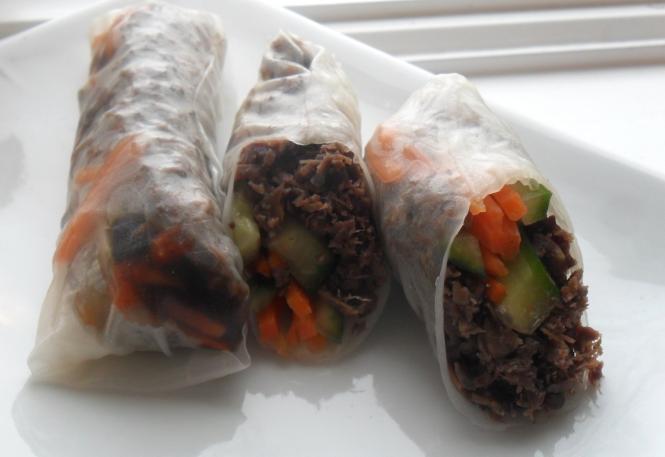This is the fifth post in a series about hunting for food -- truly meeting your meat. Also check out the earlier posts from the series: Squirrel Hunting with Mom, Duck Hunting, An Unsuccessful Pheasant Hunt, Mom Bags Her First Deer, Ice Fishing, and Making Your Own Sausages.
When I was about five years old, I lived in a small town in Illinois. The only supermarket in town was a Red Owl and on occasion they would have fried chicken gizzards in the deli. My father was a big fan of fried gizzards and we would eat several pints of fried gizzards anytime we could get them. The gizzards were very chewy and had an odd texture, but they had a wonderful flavor. That is my first memory of eating offal. During that same period of my life, I also remember eating liver for the first time. Mom would fry it in bacon grease and I would eat it with yellow mustard. Sometime after that, I realized what liver and gizzards were and I was absolutely appalled that my parents would feed that stuff to me.
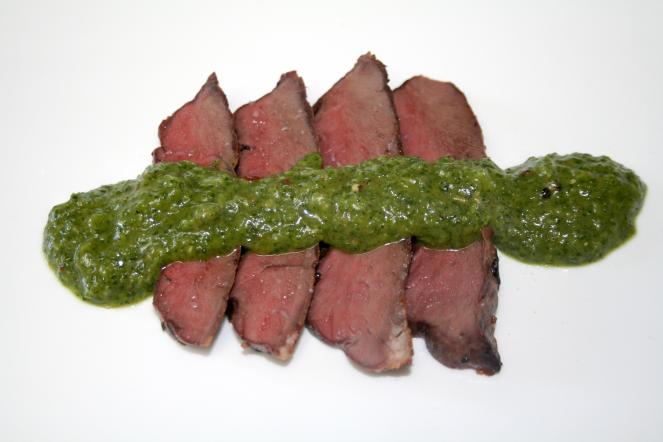 Grilled venison heart with stinging nettle chimichurri
Grilled venison heart with stinging nettle chimichurri
For some people the biggest obstacle to get over with offal isn’t the taste, it’s that they can’t get over the fact that it is an organ. They just have this mental block that says, “No, I am not supposed to eat that.” For a period of my life I was the same way, but thankfully I got over that and have been enjoying offal for most of my life. Offal is all of the parts of the animal that most people would never eat, but if cared for properly and prepared correctly, offal can be just as good as the best cuts of any animal. The most important thing to remember about offal is that freshness is everything. With cuts like the heart and tongue, you can get away with freezing them for long periods of time, but I have found that livers and kidneys are usually best fresh – the longer they sit, the stronger their flavor gets, and that isn’t always a good thing. Fresh livers and kidneys have a very pleasant almost sweet taste and are delicious sautéed with a little butter and served with mixed greens and mustard vinaigrette.
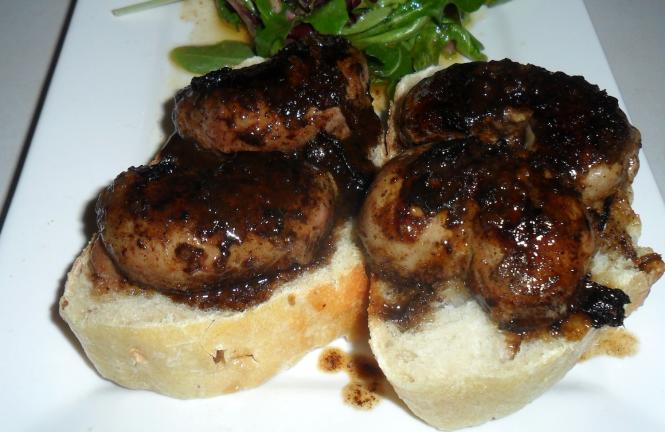 Venison kidneys with mixed greens and mustard vinaigrette
Venison kidneys with mixed greens and mustard vinaigrette
One of my favorite things to eat is venison heart. I know a lot of people think, heart, that’s disgusting. But the way I think of it is, the heart is muscle like all the rest of the animal – it just has a more intense flavor. Heart requires a little more care than the rest of the meat. First there are the arteries, which can be very chewy and are not very nice to look at. Whenever I eat heart, I like to cut it in half exposing the four chambers of the heart; I then cut away any of the valves and connective fibers. Once that is done, you end up with a couple pieces of meat that look no different than some of the other cuts of the animal. One of my favorite things to do after I get a deer is to fry the heart and serve it with some eggs for breakfast.
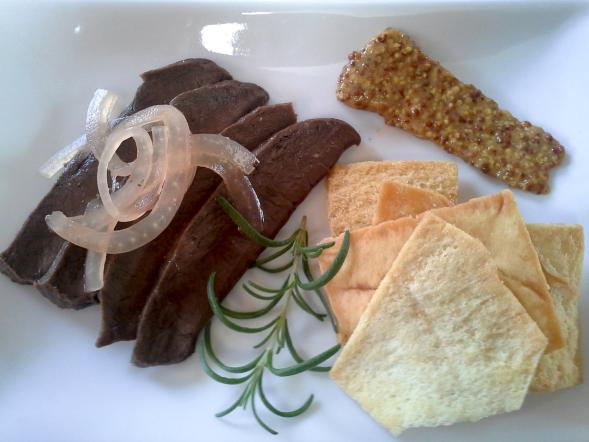 Pickled venison heart plate
Pickled venison heart plate
Livers are
probably the most versatile of the organ meats; there are endless possibilities.
Fresh livers thinly sliced and sautéed in butter are a thing of beauty, but you
can also grind the livers up and make pates and terrines with them. A couple of
years ago, I came across a recipe for Mazzafagetti, which is an Italian sausage
traditionally made with pigs’ livers. It is seasoned with
garlic, orange, and
coriander and is a brilliant way to use livers. Last year I was fortunate
enough to get out to Wyoming and shoot a couple of antelope. In my opinion,
antelope livers
are one of the great delicacies of the world. I pulled the
livers out of the antelope I shot and prepared them in a camp stew, and it was one of the best things I have ever
eaten. I also sliced a small piece of the liver and ate it raw; it was sweet
and had a very mild natural sage flavor – it was awesome. I was able to bring
back all of the livers from that trip, eight in total, and have been making everything
I can with them. I made an absolutely beautiful antelope pate and I even dry cured an antelope liver and then grated it top of roasted
beets, which turned out to be one of the best dishes I made last year.
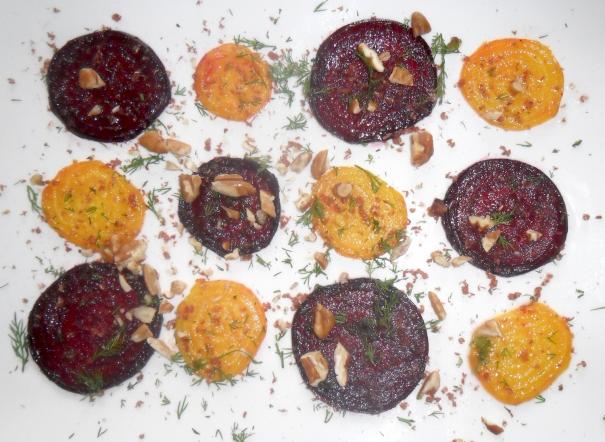 Dry cured antelope liver grated over roasted beets
Dry cured antelope liver grated over roasted beets
Offal doesn’t just apply to big game animals – it applies to birds and small game as well. Sautéed rabbit livers and kidneys are some of the best eats around. Ducks and geese provide some very good possibilities as well. Hearts, livers, and gizzards from ducks and geese can be used to make some of my favorite dishes. Duck heart tartare made with fresh duck hearts is a delicacy that most people will never try, but if they did there would be a shortage of duck hearts instantly.
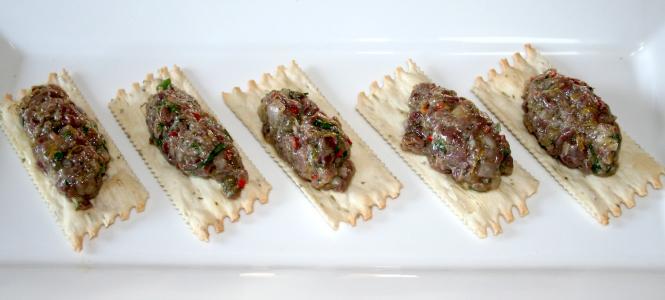 Duck heart tartare
Duck heart tartare
Whenever duck hunting I save all the hearts, livers, and gizzards, and I have a couple of buddies who save all of them for me as well. Duck gizzards are just a very dense ball of meat, but if they’re prepared correctly they can be transformed into some very tender and delicious foods. I like to confit my gizzards and then serve them with good brie cheese and a basil jelly on toast points. This year I did something different with my gizzards: I made a Chinese five-spice confit with them and then shredded the gizzards up and served them in spring rolls (pictured at top; recipe below)
 Duck gizzard confit with brie and basil jelly
Duck gizzard confit with brie and basil jelly
As a hunter, I really enjoy being able to prepare some of the odd bits of the animals I shoot because it’s important to me use as much of the animal as possible. A couple of years ago I was out in one of my favorite hunting areas and found a deer that had been shot. Whoever shot this deer just left it out in the field; they removed the backstraps – the two big loins that run along the spine – but left the rest of the animal to rot out in the field. This really upset me because I feel that as responsible hunters, we need to make an effort to use as much of the animals we shoot as possible. I am not saying that everybody who shoots a deer should take the organs home and eat them, but to kill an animal and only take the prime cuts and leave the rest to rot is criminal.
Chinese Five Spice Confit Duck Gizzard Spring Rolls
(pictured at top)
Makes about 12 spring rolls
Ingredients
- One pound duck gizzards (rinsed and cleaned)
- 1 teaspoon Chinese five spice powder
- 2 tablespoons kosher salt
- 1 quart duck fat
- 1 large cucumber (julienned)
- 1 large carrot (julienned)
- Rice paper wraps
- ½ cup rice vinegar
- 2 tablespoons sugar
- Hoisin sauce
Instructions
- Mix the five spice powder and the salt together and toss the gizzards with the mixture. Let sit overnight in the fridge.
- Rinse the gizzards and pat dry.
- Place the gizzards in a heavy oven proof pan and cover in duck fat.
- Place in the oven at 200 degrees for 4-6 hours or until the gizzards can be smashed with a fork. Then remove the gizzards from the fat and shred the meat.
- Mix together the rice vinegar and the sugar; soak the julienned carrots in this solution for at least 30 minutes.
- Follow the package’s instructions for how to prepare your rice paper wraps, then place a small amount of the shredded gizzards in the center with some cucumber and carrots and a small amount of hoisin sauce.
- Serve at room temperature and enjoy.

Jamie Carlson lives in Burnsville, MN with his wife, Amanda, and their two kids Eleanor and Charlie. He works as an Rn at the Minneapolis VA hospital. He enjoys hunting, fishing, foraging, and, of course, cooking. He believes that all food can be tasty if it is prepared with care, and he writes about his adventures cooking everything from Pickled Venison Heart to Roasted Dove on his food blog, You Have to Cook it Right. Follow him at @youcookitright. His last post for SGT was Making Your Own Sausages.

